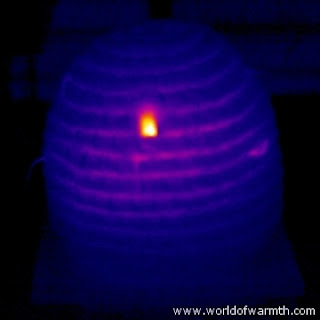 |
| Photo credit: AskNature.org |
Bees are social insects and spend their lives in colonies, or hives. They live and die in their colonies and do not migrate to warmer climates seasonally, so when the temperatures hit freezing, how do bees keep their nests? It turns out, they vibrate. The intentional vibration of their thorax creates heat so that their young can survive the cold. Intentionally creating heat or harnessing energy from vibration is not something we tend to emulate in the built environment - in fact, it accounts for energy loss and unwanted heat gain. But perhaps by harnessing vibrational energy as a source of heat, we could save energy on our mechanical systems.
Genetic diversity also plays a role in keeping the hive warm during winter. When hives are genetically diverse and sired from more than one male, they will have different comfort levels and therefor different temperature response thresholds. When a few individuals with a high threshold feel the hive is cold, they begin to vibrate. When the temperature continues to drop and others with a lower cold threshold feel the hive is cold, they begin to vibrate at that lower temperature, and so on. The colder it gets in the hive, the more bees will vibrate to maintain 32 - 36 degree Fahrenheit in the winter. The opposite is true for cooling the hive in summer when bees use their wings as fans to expel hot air. This distributed response mechanism dampens temperature spikes and keeps the hive at a livable temperature. From this, we can be inspired to set building thermostats at different thresholds to regulate staggered response, saving energy versus an "all on/all off" approach.
So what does this early spring mean for the bees? Since the warm weather has been consistent and flowers have responded to the higher temperatures by flowering, it is likely the honeybees will be fine this year. Any time the temperature is above 50 degrees, they are flying looking for food. When the temperature is warm in January and there aren't any flowers with pollen, this is damaging to the hive because they're are expending energy without bringing more food in. But since the entire ecosystem is responding to our sustained early spring, the insects should be fine for now. And abundant. Only time will tell if the same can be true for the flowers and buds, for they could die back with a hard frost and our actual spring may not be so colorful after all.
On another note, I should mention I have a particular fondness for honey bees. When my daughter was born in 2007 it was the height of the honey bee colony collapse disorder. Being a hippie at heart, I thought by naming my daughter Ellen Bee, I could help send the positive energy that I felt at her birth to the honey bees of the world and help them heal. And maybe now that the bee die-offs have been recently linked to Monsanto's corn insecticide, we can correct this horrible mistake and let the bee colonies heal. And this is so important, not just for the honey we use to sweeten our tea or the pollination benefits we enjoy for our fruit and nuts: the health and survival of all species is important to the health and survival of our ecosystems, and ourselves. End of sermon. Amen.
References:
Vibration creates heat: honeybee
Varying response thresholds aid hive thermoregulation: honeybee
Insects and the warm spring: NPR Science Friday, March 12, 2012
Where do insects go in winter?
Biomimicry BPCP Coursework

No comments:
Post a Comment